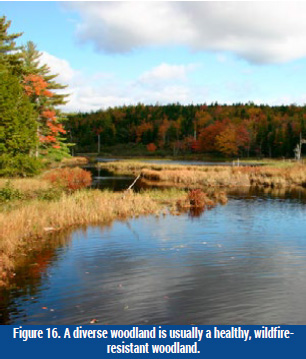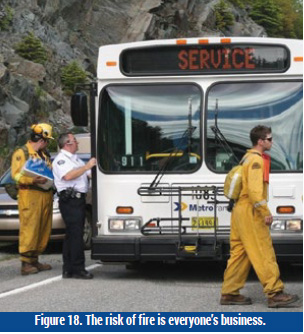Module 16: Wildfire and Your Woodland
Lesson 4 - Steps to Prevent the Rapid Spread of Wildfire
Once a wildfie has begun, it is too late to plan prevention! Planning must take place before a fie has even started. It is very important to recognize that your woodland is the fuel upon which a wildfire feeds. Do not provide a fie with an abundance of fuel! This section will address methods by which you can reduce the presence of woodland fuels.
|
|
Create Woodland Diversity
One of the ways you can plan to slow the rate of potential wildfire is by increasing the diversity of your woodland. Diversity is an important consideration when determining the rate at which a wildfie will spread. A mixture of softwood and hardwood contained in patchy and irregular stands, and with few ladder fuels, will help prevent wildfire. On the other hand, the presence of large quantities of dead softwood trees, brush, and debris will contribute to an increased risk of wildfire.
Diverse woodlands are healthy woodlands. Not only do mixtures of tree and shrub species encourage wildlife diversity, they also discourage outbreaks of forest insects and diseases. Large areas of single-species trees of the same age can be more susceptible to devastating natural events such as wind, insects, and wildfire.
Riparian areas that are found along watercourses are often some of the healthiest forest ecosystems because they support a diverse abundance of herb, shrub, and tree species. Many wildlife species also frequent these areas because of the diversity of plant and aquatic life. Large mammals use them as travel corridors. Riparian areas provide valuable natural fie breaks should a wildfie occur.
|
|
Exercise Caution Around Woodland Thinnings
If you have an area of pre-commercial or commercial thinning on your woodland, extra care should be taken to prevent fie from starting or gaining a foothold on these sites. With large quantities of dried brush present in a thinning, the likelihood exists that fires could easily ignite the brush, with the added threat that a surface fie may ladder into the crowns of the thinned trees.
Where a thinning is close to a frequently travelled road, it is a good idea to clear the brush back from the ditches and margins of the road. This will help prevent carelessly thrown butts and other sources of ignition from starting a fie in your thinning.
Respect the Hazards of Spring Season
Nearly everyone recognizes the danger present in the dry woodlands of spring. Just before hardwood buds burst and ground vegetation blossoms, wildfire hazard is at its peak. Hardwood leaves, dried by the warming sun, are crispy underfoot. Softwood twigs break in startling snaps. The heat of a sunny spring day warms the air, carrying moisture skywards. At these times, the forest is ripe with potential for wildfire.
Softwoods are at their driest in early spring. Although hardwood trees have not yet leafed out, softwood needles, twigs, and branches are highly flammable if they are dry. Needles and twigs are the fine fuels that burst i ignition and generate heat, while medium-size and heavy branches sustain hot fies by giving life to flames and embers.
When the wildfie hazard is at its peak in late spring, it may be a good idea to avoid working in the woods. At this time, mere sparks can suddenly grow into flame that may be difficult o contain. Plan your woodland activities accordingly—don’t run equipment during the hottest part of the day, and refrain from creating any kind of spark or ignition that may start a wildfie.
Remember: Your woodland is the fuel on which wildfire feeds.
|
|



